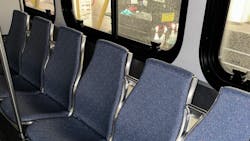Denver RTD transitioning MallRide vehicle seats from fabric to vinyl
The Denver Regional Transportation District (RTD) is transitioning the seats on its MallRide vehicles from fabric to vinyl. One of the 36 Free MallRide vehicles has been fitted with the new seats and is currently running on the MallRide route.
The entire fleet will be converted and the remainder of Denver RTD’s bus fleet will be converted to vinyl through the normal attrition cycles. The new seats will enhance the overall customer experience. The new vinyl seats can be wiped down easily and take less time for employees to clean. The fabric seats fade, show stains and need replacement more often.
The design of the seat material is the same used to update the light-rail seats. The dots symbolize the communities Denver RTD connects across the system and Denver RTD’s brand colors are represented in the pattern. The design was chosen in 2023 by employees and was created by an in-house graphic designer.
“The MallRide vehicles were identified for initial retrofit among Denver RTD’s bus fleet because of its heavy usage. The interior of these buses is heavily exposed to the effects of Colorado winter weather, including rain and snow,” said Denver RTD General Manager and CEO Debra A. Johnson. “While most Denver RTD buses have one or two doors that open only when customers enter and exit, each of the vehicles in the MallRide fleet has three extra-wide doors that open at every block along the MallRide route. The upgrade these buses will receive benefits everyone, from the customers using the vehicles to the Denver RTD team members who clean and maintain them.”
“The new vinyl material is heavy duty, lighter in color and, in my opinion, just as comfortable, if not more so than the cloth material,” said Fred Worthen, Denver RTD assistant general manager of bus. “Vinyl does not absorb liquids; thus, it is very apparent when a seat is wet. It matches the interior better, giving a brighter and more fluid appearance to the interior of the bus. It is also lower maintenance, allowing us to dedicate more time to full interior cleanings rather than having to strictly clean seats every 3,000 miles.”
